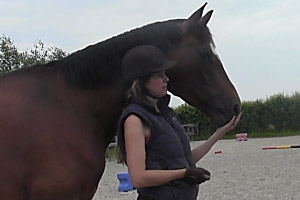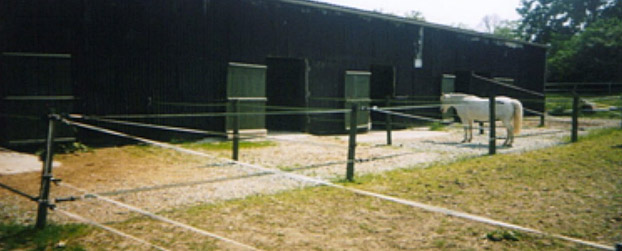‘In 1997 one of Kat’s horses had developed some quite serious COPD symptoms. This was a condition the horse had when she was purchased and was predominantly a result of her being sensitive to the dusty conditions stabling causes. As a result Kat began to experiment with keeping the horses in a more natural environment, living out all year round in a herd. The benefits to the horses’ health and emotional wellbeing extended way beyond COPD symptoms and Kat became hooked on this ‘natural’ method of keeping horses.
In the following text Kat explains more about her views on keeping horse more naturally.
When I first started keeping my horses ‘naturally’ in 1997 I was viewed as somebody who didn’t care about the welfare of their horses, who took the easier option! It isn’t the easier option but in my opinion it is often the best option for the welfare of the horse. There is now a huge movement of horse owners who recognise and share my sentiments. I am not anti-stable, I recognise there are situations when it is helpful or necessary to have a horse stabled and have had to do so myself at times. I do understand that there are many horse owners who are stuck with no alternatives. However, we owe it to our horses’ emotional and physical well-being to try and provide natural living and feeding conditions and that if they do have to be stabled, every possible factor has been considered, to make that unnatural environment as natural and environmentally enriched as possible.
By 2000 Kat had kept her three horses living out, all year round, for 3 years. Over those years she experienced first-hand how hard it was to find the right type of all year turnout environment for her horses i.e. enough grazing to sustain the field from being too poached in the winter; hard standing for feeding hay so the horses’ legs and feet can dry out to reduce the risk of mud fever, cracked heels and abscesses; a roofed shelter big enough to support the total number of horses in the herd; and an arena - a tall order!!
Although Kat continued to keep her horses naturally, using an open barn attached to good grazing, the recognition of how hard it was to find alternatives led her to create and build an ‘alternative’ livery yard ‘The Centre for Horse Sense’. The yard offered an alternative method of stabling horses and a compromise between conventional stabling and natural living by providing indoor stables and attached outdoor corrals. Kat designed and built the yard herself when she was 26 years old.
Kat explains more about The Centre for Horse Sense
In 2000 I rented an empty barn and 20 acres and set about building an ‘alternative’ livery yard. I could have fitted 20 stables in the barn but chose to build 10 to provide the horses with more indoor space. I then created outdoor corrals, attached to every stable, so that the horses had double the space and could choose whether they wanted to be inside or outside. The stable walls were kept lower than normal so the horses could touch each other and mutual groom if they wished. The horses had a full height partitions in certain areas of the stables so hay and hard feed could be fed safely if required. The stables and outdoor corrals were 27ft x 14ft. The livery horses still had all year full daily turn out. The yard was a huge success for horses that would otherwise have been kept in conventional stabling.
Photo of the outdoor corrals at the Centre for Horse Sense
The following text is an account by Kat of her behavioural observations of the horses kept in this alternative system of housing in 2002.
My observations from this experimental yard were that: all new horses, bar one, settled very quickly in their alternative housing conditions; no new stereotypic behaviour was exhibited; the horses’ chose to stand outside more than inside, with the exception of very windy conditions and driving rain when they predominantly preferred to shelter inside; drizzly rain did not appear to bother the horses, who would often be seen standing outside in the corrals in it; horses frequently sniffed and touched each other and geldings would often ‘play’ over the stable walls and herd mates stabled in adjoining boxes would often rest standing next to each other. On many occasions my Shetland pony Barney would limbo under the corral of one of his ‘favourite’ daytime herd mates and spend the night sharing a stable with him! Only one horse didn’t settle into the alternative type of stabling. This was a horse that had very established stereotypic behaviours (windsucking and box walking). Unfortunately he didn’t seem able to settle into the semi-freedom environment the alternative stables provided him with. After 1 month of persevering with the horse in the alternative stables, the owner insisted the horse was put back into his old conventional stable as he was ‘calmer’ in it and exhibited less frequency in his stereotypic behaviours. We did not put a windsucking collar on him but chose to let him exhibit this behaviour by attaching a wooden bar to his stable door so he could hold onto that to ‘suck’ instead of damaging the door. This did not cause him any colic symptoms. The irony in this situation was that the conventional stabling that had caused him to have those behaviours, in the end gave him more security. Only a longer period of acclimatisation in the alternative setting would have shown if that horse would have eventually become more settled and whether or not his stereotypic behaviours would have remained or become less frequent, sadly for him that was not an option.
If you are interested in keeping your horses in a more natural environment, Kat can visit your yard, discuss her experiences and offer advice on how your premises could be adapted. Additionally she offers talks to individuals or groups on natural living options. Please email Kat at thinkingequitation@gmail.com
If your yard offers natural or alternative livery and you would like it to be added to a list of natural and alternative UK livery yards. Please email thinkingequitation@gmail.com with your contact details.





















